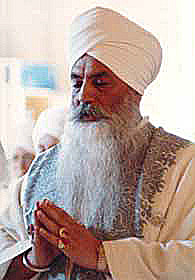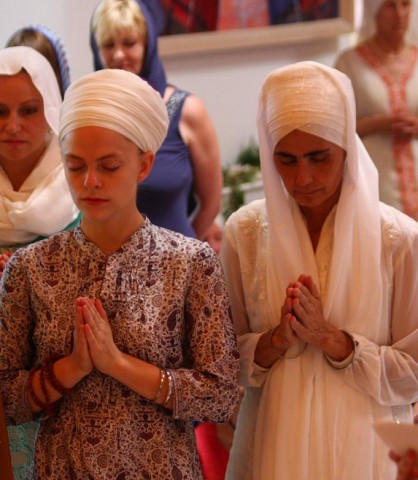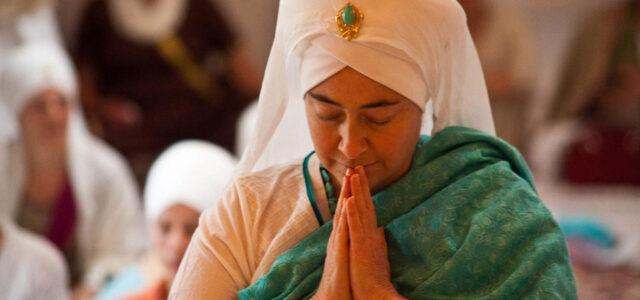“When the prayer becomes the vibration of the mind and self, then we can create a miracle.”
—The Siri Singh Sahib Bhai Sahib Harbhajan Singh Yogiji
The word “Ardas” literally means “prayer.” But the traditional Sikh Ardas has come to represent a specific form of prayer recited in every Gurdwara program. It is recited before the Guru is transported or brought into Prakaash, just before the hukam is taken, and again when the Guru is set into Sukhasaan. It can also be recited before undertaking any activity of significance, before leaving on a journey, to give thanks, or as a way of daily remembering the Creator.
 The core of Ardas is an invocation which Guru Gobind Singh recited at the beginning of his epic poem Chandi di Vaar. In it, he calls upon the power of Adi Shakti in the form of Pritham Bhagauti. He then calls upon the Spirit of the Guru, elaborating upon the nine manifestations from Guru Nanak through Guru Teg Bahadur. This part of Ardas is unchangeable and should be recited in the original Gurmukhi, if possible. Sikh ministers should be able to recite this short prayer from memory, and should be prepared to offer Ardas at any time, at the request of the Sangat.
The core of Ardas is an invocation which Guru Gobind Singh recited at the beginning of his epic poem Chandi di Vaar. In it, he calls upon the power of Adi Shakti in the form of Pritham Bhagauti. He then calls upon the Spirit of the Guru, elaborating upon the nine manifestations from Guru Nanak through Guru Teg Bahadur. This part of Ardas is unchangeable and should be recited in the original Gurmukhi, if possible. Sikh ministers should be able to recite this short prayer from memory, and should be prepared to offer Ardas at any time, at the request of the Sangat.
The remainder of Ardas honors the memory of Guru Gobind Singh, his four sons, and those Sikhs who have sacrificed and kept up in the face of adversity. Since this part of Ardas was not composed by the Gurus, it is most appropriate for this to be recited in the language of the people attending Gurdwara. Many ministers recite this from memory, but many others prefer to read it. In either case, it should bring the Sangat back to this crucial remembrance of sacrifice and surrender; it should not become an empty ritual. Remember that you are not merely reading Ardas; you are leading the Sangat, channeling the group energy towards creative manifestation and remembrance.
The description of the sacrifices made is quite graphic, and any translation should preserve this element. Toward the end of Ardas, a blessing is asked for the Guruparshad, and the Lungar. Personal remembrances may be added at this time for birthdays, deaths, anniversaries, and sacrifices, and prayers for health and recovery from illness or adversity. It is also a tradition to ask for a blessing for one’s Spiritual Teacher. Many ask for blessing for the Siri Singh Sahib, whose sacrifice led so many thousands to the Feet of the Guru.
The closing line: “Nanak Naam, Chardee Kala, Tere Bhaane Sarbat Daa Bhalaa (Through Nanak, May Thy Name Forever Increase and the Spirit Be Exalted and May All People Prosper By Thy Grace!) must be used to end the Ardas.
It falls within the duties of the Singh Sahib or Sardarni Sahiba to ensure that Ardas is properly done. Anyone in the Sadh Sangat may offer the Ardas. That person should have some familiarity with the Sikh history referred to and should have an understanding of the concepts involved so the prayer can be offered with understanding and not as a ritual. Any words may be used to invoke blessings from the Guru but should not be used as an opportunity to preach or lecture to the sangat. The Ardas should be in a flowing rhythm. The person offering the Ardas removes his or her socks and washes the hands.
Short Ardas: Under certain circumstances (i.e., after Kirtan Sohila and Sukhaasan), it is appropriate to recite a shortened Ardas. This should include the Invocation up to “Sabh thaee hoee saha-ee,” and end with “Nanak naam chardee kala, tere bhaane sarbat daa bhalaa,” with the personal addition in between.
What is Ardas?
by Bhai Sahiba SS Dr. Bibi Inderjit Kaur Khalsa, PhD
It is our delight and blessing as a sangat to stand together, hands folded and offer our group mind and soul in prayer, with Ardas. Just like everything else we do, we first experience the ecstasy with our kirtan, meditation, whatever we are engaged in. Then, we stand and offer that ecstasy in gratitude and to energetically and with spirit, stand in the present moment, strong as steel, steady as stone, soft as wax in love. Our Ardas is an elevation and a standing to our Khalsa values, and victory of the spirit. Ardas offers a deep sense of continuity of these values, of honoring the past, standing together in the present, and facing the future with confidence in and calling upon God and Guru. Just like Guru Gobind Singh offered Ardas, the sadh sangat through history has done.
The person reciting the Ardas is representing the sadh sangat. The content of the Ardas can be put into ones own words, but within a certain structure, and needs to include and bring into the psyche certain themes which honor our great past, acknowledge the present, and moving forward with God and Guru leading us into the future.
 The 4-part Structure of Ardas:
The 4-part Structure of Ardas:
PRAISING THE INFINITE
The opening words of Ardas are from the Chandi Ki Vaar of Guru Gobind Singh ji and calls first upon and acknowledges the Infinite Almighty of all! Then it calls upon Siri Bhagauti, the Adi Shakti, the Primal Power as Sword! Then Guru Gobind Singh bows to the Mastery and blessing of the nine Gurus whose light he represents. This ends with Sabh Thaa-ee Ho-e Sahaa-eh. It is best to recite this invocation in Gurmukhi. The rest of the Ardas (including a translation of this segment) can be recited in the language most understood by the majority of the sangat. It is appropriate to add to this section Praise of Guru Gobind Singh and of the Siri Guru Granth Sahib, to complete the invocation.
REMEMBERING AND HONORING OUR PAST
The next part can be put into ones own words, and here there is flexibility. But it needs to be contained within a certain structure, and needs to include and bring into the psyche honoring of the great people and events of our great history to inspire, elevate us and re-confirm our values. You can make this as long or short as you need or are inspired to. It can be in poetic form or prose. (Is there anything quite as beautiful as Guru Kirn Kaurs poetic Ardas in English?) This section should include: Panj Piare, 40 liberated ones, 4 saahibzadas, the great men and women throughout our history whose known and unknown prayers, sacrifices, acts of kindness, discipline, devotion and love brought the panth into the future. The takhats and sacred places Asking for the experience of the Hari Mandir Sahib (the Golden Temple) glory of the panth, sustenance of the panth May Truth prevail. These are some of the themes that fulfill our Ardas.
THE PRESENT MOMENT
Offering our present lives unto God and Guru in gratitude, deep humility, and for blessing. Here is the opportunity for the personalized part of the Ardas when the speaker calls forth the particular purpose of the Ardas, the particular blessing of an individual, event, undertaking, or need of the sadh sangat.
BLESSING ALL UNTO THE FUTURE
Then the unchangeable, expansive blessing for all, which reflects the Sikh spirit:
Nanak Naam Chardhi Kalaa Tayray Bhaanay Sarbat da Bhalaa!
Wahe Guru Ji Ka Khalsa, Wahe Guru Ji Ki Fateh!
Bole So Nihal! Saaaaaat Siri Akaaal!
Enjoy this beautiful poetic translation of Ardas by Sardarni Sahiba Guru Kirn Kaur of Phoenix, AZ.
©Photos courtesy SS Gurumustuk Singh Khalsa


